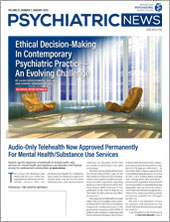The kind of online content children and adolescents view may be associated with their risk of subsequent suicide-related behaviors, a study in JAMA Network Open has found.
The study examined the relationship between risk of suicidal-related behavior and eight types of potentially harmful online content—cyberbullying, drug related, sexual, violence, hate speech, profanity, depression, and low-severity suicide/self-harm (third-party content about suicide or self-harm that is viewed, but not sent, by the student).
“We know from prior clinical or public health studies that many of these behaviors, like drug use, violence, and depression, are risk factors for youth suicide, but what our study adds is an understanding that when these risk factors show up in a child’s online activities they are also signals for suicide-related behavior,” lead author Steven A. Sumner, M.D., M.Sc., told Psychiatric News. Sumner is the senior advisor for data science and innovation at the Centers for Disease Control and Prevention’s National Center for Injury Prevention and Control in Atlanta.
Sumner and colleagues examined data from 1,362 youth (average age 13 years) who went to schools that participated in an online safety monitoring program. The schools used the Bark online safety tool, which monitors the content students send and view and alerts school administrators and parents to content that may threaten the students’ health and well-being, such as messages about self-harm, suicidal ideation, online predators, bullying, and threats of violence.
Between July 27, 2019, and May 26, 2020, 227 youth had one or more severe suicide/self-harm alerts requiring notification of school administrators, with severe suicide/self-harm alerts defined as statements by youth that are identified by the Bark tool as indicating imminent or recent suicide attempts and/or self-harm. The researchers compared the online behaviors of these youth with those of five controls each (youth enrolled in the same school who participated in a similar volume of online activity) to examine whether there were differences between the two groups that preceded the notifications about the severe suicide/self-harm alert.
Cyberbullying was the most common risk factor, comprising 1.97% of all online activities among students in the severe alert group compared with 0.96% among students in the control group.
“Some risk factors, like bullying, can contribute to suicide risk in multiple ways. Bullying can have a direct effect and cause a young person to attempt suicide, while longer term exposure to bullying can also have an indirect effect on suicide by increasing depression in that youth, which then also increases their risk for suicide,” Sumner said.
Depression-related content had the largest association with subsequent severe suicide/self-harm alerts: Students who posted or shared depression-related content had 1.82 times the odds of a subsequent alert compared with those who did not view such content. Depression-related content was followed by low-severity suicide/self-harm (1.76 times the odds) and profanity (1.7 times the odds). Youth with five or more of the eight risk factors had more than 78 times the odds of having a subsequent alert than those who did not have any risk factors.
“Our study shows that it is important to be aware of what children are exposed to and posting online,” Sumner said. “Closer attention to online risk factors can potentially identify red flags for youth suicide early and lead to improved prevention. Hopefully this work opens up more avenues for both clinicians and parents to talk with young people about online environments, mental health, and suicide.”
The researchers reported no outside funding for their study. ■
“Association of Online Risk Factors With Subsequent Youth Suicide-Related Behaviors in the US” is posted
here.

